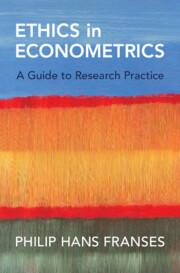Book contents
- Ethics in Econometrics
- Ethics in Econometrics
- Copyright page
- Contents
- Figures
- Tables
- Preface
- Acknowledgments
- Recommended Reading
- Introduction
- 1 Ethical Guidelines
- 2 Scientific Misconduct
- 3 Influential Observations
- 4 Model Selection
- 5 Estimation and Interpretation
- 6 Missing Data
- 7 Spurious Relations
- 8 Blinded by the Data
- 9 Predictability
- 10 Adjustment of Forecasts
- 11 Big Data
- 12 Algorithms
- Conclusion
- Index
- References
5 - Estimation and Interpretation
Published online by Cambridge University Press: 14 November 2024
- Ethics in Econometrics
- Ethics in Econometrics
- Copyright page
- Contents
- Figures
- Tables
- Preface
- Acknowledgments
- Recommended Reading
- Introduction
- 1 Ethical Guidelines
- 2 Scientific Misconduct
- 3 Influential Observations
- 4 Model Selection
- 5 Estimation and Interpretation
- 6 Missing Data
- 7 Spurious Relations
- 8 Blinded by the Data
- 9 Predictability
- 10 Adjustment of Forecasts
- 11 Big Data
- 12 Algorithms
- Conclusion
- Index
- References
Summary
In practice it may happen that a first-try econometric model is not appropriate because it violates one or more of the key assumptions that are needed to obtain valid results. In case there is something wrong with the variables, such as measurement error or strong collinearity, we may better modify the estimation method or change the model. In the present chapter we deal with endogeneity, which can, for example, be caused by measurement error, and which implies that one or more regressors are correlated with the unknown error term. This is of course not immediately visible because the errors are not known beforehand and are estimated jointly with the unknown parameters. Endogeneity can thus happen when a regressor is measured with error, and, as we see, when the data are aggregated at too low a frequency. Another issue is called multicollinearity, in which it is difficult to disentangle (the statistical significance of) the separate effects. This certainly holds for levels and squares of the same variable. Finally, we deal with the interpretation of model outcomes.
Keywords
- Type
- Chapter
- Information
- Ethics in EconometricsA Guide to Research Practice, pp. 113 - 138Publisher: Cambridge University PressPrint publication year: 2024

